B1 - Cell Structure and Transport
1/74
Earn XP
Description and Tags
Name | Mastery | Learn | Test | Matching | Spaced |
|---|
No study sessions yet.
75 Terms
How many metres in 1km?
1km = 1000m
How many centimetres in 1m?
1m = 100cm
How many millimetres in 1cm?
1cm = 10mm
How many micrometres in 1mm?
1mm = 1000μm
How many nanometres in 1μm?
1μm = 1000nm
How do light microscopes form images?
Light microscopes use a beam of light to form images.
What is the maximum magnification of a light microscope?
The best light microscopes can go up to x2000.
What are some characteristics of light microscopes?
Light Microscopes:
are relatively cheap
can magnify live specimens
How do electron microscopes form images?
Electron microscopes use a beam of electrons to form images.
What is the maximum magnification of an electron microscope?
The best electron microscopes can magnify up to x2,000,000.
What are some characteristics of electron microscopes?
Electron Microscopes:
can see subcellular structures inside cells
are large
are very expensive
must be kept in special temperature, pressure, and humidity
What are the 2 types of electron microscopes?
Transmission Electron Microscopes
Scanning Electron Microscopes
What are some characteristics of Transmission Electron Microscopes?
Transmission Electron Microscopes:
have very high-resolution
can reach very high magnification
2D
What are some characteristics of Scanning Electron Microscopes?
Scanning Electron Microscopes:
Lower magnification
3D
What are the equations for magnification?
Magnification = Eyepiece Lens Magnification x Objective Lens Magnification.
Magnification = Size of Image / Size of Real Object
What is the resolving power of a microscope?
The resolving power of a microscope is how much detail it can show.
What is the resolving power of:
A Light Microscope?
A Transmission Electron Microscope?
A Scanning Electron Microscope?
The resolving powers of:
A Light Microscope - about 200nm
A Transmission Electron Microscope - about 0.2nm
A Scanning Electron Microscope - about 10nm
How long are animal cells?
Animal cells are around 10-30μm long.
List all of the subcellular organelles in an animal cell. Provide their functions.
The subcellular organelles in an animal cell are:
Nucleus - controls all activities of the cell.
Cytoplasm - the liquid gel containing the organelles, where all the chemical reactions occur.
Cell Membrane - controls what enters and leaves the cell.
Mitochondria - does aerobic respiration, provides energy for the cell.
Ribosomes - does protein synthesis
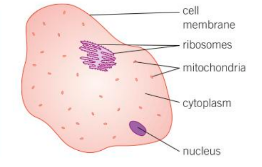
How long is the average plant cell?
A plant cell is usually around 10-100 μm long.
What does a plant cell have that an animal cell doesn’t? State their functions.
Features of the plant cell that the animal cell doesn’t have:
Cell wall - made of cellulose, supports/strengthens cell.
Chloroplasts - contain chlorophyll, does photosynthesis.
Permanent Vacuole - filled with cell sap, keeps cell rigid/turgid.
What type of cells are Eukaryotic?
Animal Cells and Plant Cells.
Do eukaryotic cells have a nucleus?
Eukaryotic cells have a nucleus.
What is DNA?
DNA is genetic material which forms structures called chromosomes.
What type of cells are prokaryotic?
Bacterial Cells are prokaryotic.
What is different about the cell wall of a bacterial cell?
A bacterial cell wall has no cellulose.
Where is the genetic material of a bacterial cell?
The DNA is floating around the cytoplasm of a bacterial cell. No nucleus.
What other structure may a bacterial cell contain for DNA?
A bacterial cell may have plasmids for very specific features.
What order of magnitude would 100x bigger be?
10²
What is differentiation?
Differentiation is when cells develop to form different types of specialised cells.
When do most animal cells differentiate?
Most animal cells specialise at an early stage of development
When do most plant cells differentiate?
Many types of plant cells retain the ability to differentiate throughout life.
How are nerve cells specialised?
Nerve cells are specialised to carry electrical impulses around an animal body.
What are the adaptations of nerve cells? What do these adaptations do?
Adaptations:
Lots of dendrites - make connections to other nerve cells.
An axon - carries the nerve impulse from one place to another.
Synapses - pass the impulses to another cell or between a nerve cell and a muscle in the body using special transmitter chemicals.
What do muscle cells do?
Muscle cells are specialised cells that can contract and relax in pairs to move bones.
What are the three main adaptations of muscle cells?
The three main adaptations of muscle cells:
Contain special proteins which slide over each other making fibres contract.
Contain many mitochondria to transfer energy needed for reactions.
Can store glycogen which is used in cellular respiration by mitochondria.
What do sperm cells do?
Sperm cells contain DNA from the male parent - they attempt to break into the female egg cell to fertilise it.
What are the adaptations of the sperm cell?
Adaptations of sperm cells:
Long tail to swim to the egg.
A middle section - full of mitochondria to get the energy required to move.
A large nucleus that contains the DNA of the male parent.
An acrosome - breaks down the outer layers of the egg cell.
What do root hair cells do?
Root hair cells help take up water and mineral ions for plants. They are relatively close to the xylem tissue which carries the water and mineral ions up into the rest of the plant.
What are the main adaptations of root hair cells?
Root hair cells have three main adaptations:
Greatly increased surface area - allows more water to move into the cell.
Large permanent vacuole - speeds up the movement of water by osmosis.
Many mitochondria - transfer the energy needed for the active transport of mineral ions into the root hair cells.
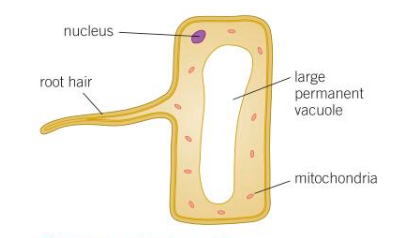
What do photosynthetic cells do?
Photosynthetic cells carry out photosynthesis.
What are some of the adaptations of photosynthetic cells?
Adaptations of photosynthetic cells:
Contain specialised green structures called chloroplasts - contain chlorophyll that traps the light needed for photosynthesis.
Usually positioned in continuous layers in the leaves and outer layers of the stem of a plant - absorb as much light as possible.
Large permanent vacuole - helps keep cell rigid as a result of osmosis. Also keeps the leaf spread out to capture as much light as possible.

What do Xylem Cells do?
Xylem is the transport tissue in plants that carries water and mineral ions from the roots to the rest of the plant. Also supports the plant.
What are the adaptations of xylem cells?
Xylem cells are adapted in these ways:
Xylem cells start off alive but a special chemical called lignin builds up in spirals in the cell walls. The cells die and form long hollow tubes that allow water and mineral ions to move easily through them.
The spirals and rings of lignin make the xylem cells very strong and help them withstand the pressure of water moving up the plant. Also supports the plant stem.
What do phloem cells do? What are they made of?
Phloem is a transport tissue that carries food from photosynthesis around the plant.
Phloem is made up of phloem cells that also form tubes like xylem cells, however, they do not become lignified and die.
What are the adaptations of phloem cells?
Adaptations of phloem cells:
Cell walls between the cells break down to form special sieve plates - allow water carrying dissolved food to move freely up and down the tubes.
Lose a lot of their internal structures but are supported by companion cells to keep them alive. The mitochondria of these companion cells transfer the energy needed to move dissolved food up and down the plant in phloem.
What is diffusion?
Diffusion is the net movement of particles from an area of high concentration to an area of lower concentration of the particles (down the concentration gradient) through a semi-permeable membrane.
Would a big difference in concentration make diffusion faster of slower? What about a small difference in concentration?
Big difference / steeper concentration gradient = faster rate of diffusion.
Small difference / less steep gradient = slower rate of diffusion.
What is the formula for net movement?
Net movement = particles moving in - particles moving out.
How does temperature affect the rate of diffusion?
A higher temperature will lead to faster diffusion.
How does oxygen diffuse into your body?
Oxygen passes from your lungs into red blood cells by diffusion.
Oxygen moves down the concentration gradient from the lungs to the red blood cells.
Oxygen then moves down the concentration gradient from the red blood cells into the cells where oxygen is needed.
CO2 diffuses in the opposite direction.
What is gas exchange?
The diffusion of oxygen and carbon dioxide in opposite directions.
What is osmosis?
Osmosis is the movement of water molecules pass from a solution of low concentration to a solution of high concentration (down a concentration gradient) through a semi-permeable membrane.
What is the difference between a dilute solution of sugar and a concentrated solution of sugar?
A dilute solution of sugar contains a high concentration of water and a low concentration of sugar.
A concentrated solution of sugar contains a low concentration of water and a high concentration of sugar.
What does is it mean if a solution is isotonic to the cell?
If a solution is isotonic to the cell, the concentration of solutes in the solution outside the cells is the same as the internal concentration.

What does it mean if a solution is hypertonic to the cell?
If a solution is hypertonic to the cell, the concentration of solutes in the solution outside the cell is higher than the internal concentration.

What does it mean if a solution is hypotonic to the cell?
If a solution is hypotonic to the cell, the concentration of solutes in the solution outside the cell is lower than the internal concentration.
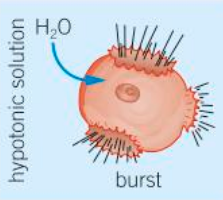
What is turgor?
Turgor is the pressure when water moves into a cell by osmosis and causes the vacuole to swell. The cytoplasm is pushed against the plant cell wall and the pressure builds up until no more water can enter the cell.
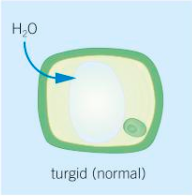
Do plants want a hypertonic or hypotonic solution around their cells? Why?
Plants want the solution outside their cells to be hypotonic with a lower concentration of solutes and more water than the cells. This keeps water moving by osmosis in the right direction and keeps the cell turgid.
What if the solution outside the plant cells is hypertonic?
If the solution outside the cell is hypertonic, then the cells will become flaccid as there is no pressure inside the cell acting on the cell wall. The plant will wilt as turgor no longer supports the plant tissues.

What if too much water is lost by osmosis in a plant cell? What is the name of this process?
If more water is lost by osmosis, the vacuole and cytoplasm shrink and eventually the cell membrane pulls away from the cell wall. This is called plasmolysis. Plasmolysed cells die quickly unless osmotic balance is restored.

How would you investigate the effect of osmosis on plant tissue?
Place a piece of peeled potato into sugar solutions of different concentrations.
If the solution is hypotonic, water will move into the cells by osmosis. This is because the concentration of sugar in the solution is very low compared to the water - therefore, the water will move into the piece of potato along the concentration gradient and the potato will increase in size.
If the solution is hypertonic, water will move out by osmosis. This is because the concentration of sugar in the solution is very high compared to the water - therefore, water will move out of the potato along the concentration gradient and the potato will shrink.
What is active transport?
Active transport is the movement of a substance from an area of low concentration to an are of high concentration (against the concentration gradient) through a semi-permeable membrane. This uses energy.
Why is active transport important?
Active transport allows cells to absorb ions from very dilute solutions.
How is respiration and the rate of active transport linked?
Since active transport requires energy, the rate of cell respiration that produces the energy required for active transport is closely linked to the rate of active transport.
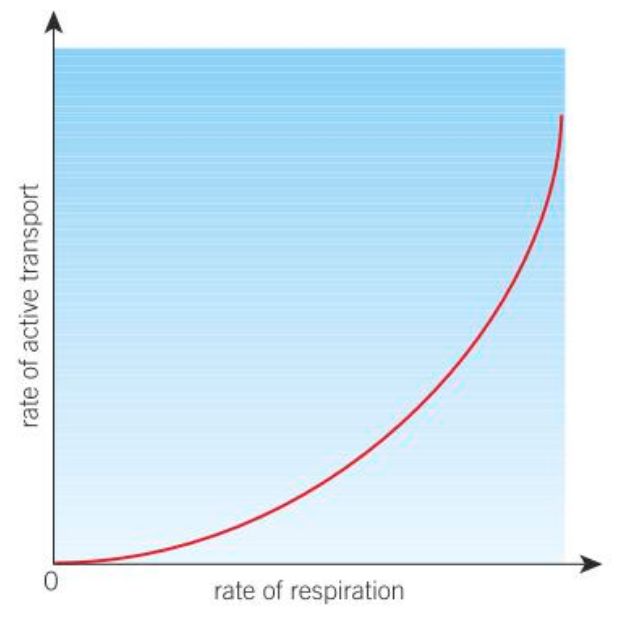
Why do cells involved in active transport have many mitochondria? Give examples of cells.
Cells involved in active transport have a lot of mitochondria to provide the energy required for active transport.
Examples of cells:
Root hair cells in plants
The cells lining your gut
Why is active transport important for plants?
Mineral ions in soil are usually found in very dilute solutions which are more dilute than the solution within the plant’s root hair cells. Therefore, active transport is required for the plant to absorb these ions.

Why is active transport important for animals?
Sugars, such as glucose, is always actively absorbed out of your gut and kidney tubules into your blood, often against a large concentration gradient.
Glucose is required for cell respiration, so it is very important for active transport to move as much glucose as possible from your gut to your blood.
Why is diffusion, osmosis, and active transport all that is needed for single-celled organisms?
The surface area : volume ratio of most single-celled organisms is fairly large - so diffusion, osmosis, and active transport is all that is needed.
What happens to SA:V ratio as objects get bigger?
As objects get bigger, the SA:V ratio falls.
What would the SA:V ratio be in a small object and what effect would this have on the object?
In a small object, the SA:V ratio would be relatively large. This means that diffusion distances are short and simple diffusion is sufficient for the exchange of materials.
What would the SA:V ratio be in a large object and what effect would this have on the object?
In a large object, the SA:V ratio would be smaller. This means that the diffusion distances are bigger and simple diffusion is no longer sufficient for the exchange of materials.
What are the effects of a smaller SA:V ratio on an organism? How do large organisms combat this?
If an organism had a low SA:V ratio:
Gases and food molecules can no longer reach every cell inside the organism by simple diffusion.
Metabolic waste cannot be removed fast enough to avoid poisoning the cells.
Large organisms have adapted, special surfaces where the exchange of materials takes place to combat this.
What are the adaptations for exchanging materials?
Adaptations for exchanging materials:
Large surface area
Thin membrane to provide a short diffusion path.
In animals, an efficient blood supply to move the diffusing substances away from the exchange surfaces and maintain a steep concentration gradient.
In animals, being ventilated - maintains steep concentration gradients.
What are some examples of adaptations for exchanging materials?
Alveoli and Villi:
Alveoli are tiny air sacs in your lungs.
When you breathe, the alveoli in your lungs are ventilated.
Alveoli/Villi have an enormous surface area.
Alveoli/Villi have a very rich blood supply.
Villi have short diffusion paths.
Fish Gills:
Gills are made up of stacks of thin filaments, each with a rich blood supply.
Gills have a constant flow of water to maintain a concentration gradient - do this by pumping water over gills using a flap that covers the gills called the operculum.
Plant Roots:
Large surface area
Water constantly moves away from the roots in the transpiration stream - maintains a steep concentration gradient.
Plant Leaves:
Flat, thin leaves
Presence of air spaces in the leaf tissues.
Stomata
All provide a big surface area and maintain a steep concentration gradient.